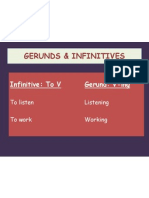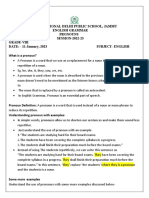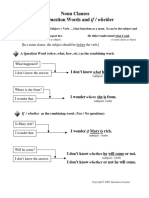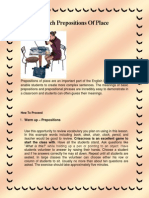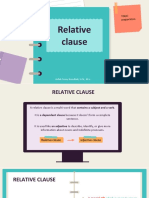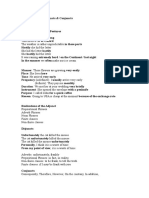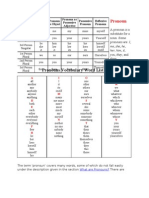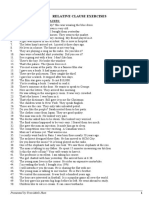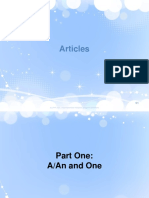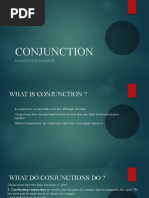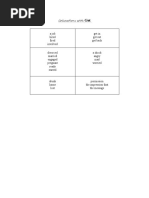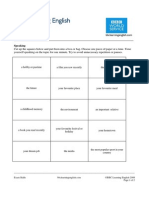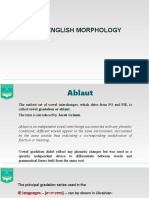0 ratings0% found this document useful (0 votes)
353 viewsConjunctions
Conjunctions
Uploaded by
Samar HamadyConjunctions are words that join two parts of a sentence. There are two main types: coordinating conjunctions and subordinating conjunctions. Coordinating conjunctions join grammatically equal parts of a sentence, while subordinating conjunctions join a dependent clause to an independent clause. Some common coordinating conjunctions are and, but, or, nor, for, yet, so. Common subordinating conjunctions include after, although, as, because, before, how, if, once, since, than, that, though, till, until, when, where, whether, while. Conjunctions can be single words, compound words, or correlative pairs of words.
Copyright:
© All Rights Reserved
Available Formats
Download as DOCX, PDF, TXT or read online from Scribd
Conjunctions
Conjunctions
Uploaded by
Samar Hamady0 ratings0% found this document useful (0 votes)
353 views4 pagesConjunctions are words that join two parts of a sentence. There are two main types: coordinating conjunctions and subordinating conjunctions. Coordinating conjunctions join grammatically equal parts of a sentence, while subordinating conjunctions join a dependent clause to an independent clause. Some common coordinating conjunctions are and, but, or, nor, for, yet, so. Common subordinating conjunctions include after, although, as, because, before, how, if, once, since, than, that, though, till, until, when, where, whether, while. Conjunctions can be single words, compound words, or correlative pairs of words.
Original Description:
Conjunctions
Copyright
© © All Rights Reserved
Available Formats
DOCX, PDF, TXT or read online from Scribd
Share this document
Did you find this document useful?
Is this content inappropriate?
Conjunctions are words that join two parts of a sentence. There are two main types: coordinating conjunctions and subordinating conjunctions. Coordinating conjunctions join grammatically equal parts of a sentence, while subordinating conjunctions join a dependent clause to an independent clause. Some common coordinating conjunctions are and, but, or, nor, for, yet, so. Common subordinating conjunctions include after, although, as, because, before, how, if, once, since, than, that, though, till, until, when, where, whether, while. Conjunctions can be single words, compound words, or correlative pairs of words.
Copyright:
© All Rights Reserved
Available Formats
Download as DOCX, PDF, TXT or read online from Scribd
Download as docx, pdf, or txt
0 ratings0% found this document useful (0 votes)
353 views4 pagesConjunctions
Conjunctions
Uploaded by
Samar HamadyConjunctions are words that join two parts of a sentence. There are two main types: coordinating conjunctions and subordinating conjunctions. Coordinating conjunctions join grammatically equal parts of a sentence, while subordinating conjunctions join a dependent clause to an independent clause. Some common coordinating conjunctions are and, but, or, nor, for, yet, so. Common subordinating conjunctions include after, although, as, because, before, how, if, once, since, than, that, though, till, until, when, where, whether, while. Conjunctions can be single words, compound words, or correlative pairs of words.
Copyright:
© All Rights Reserved
Available Formats
Download as DOCX, PDF, TXT or read online from Scribd
Download as docx, pdf, or txt
You are on page 1of 4
Conjunctions
A conjunction is a word that "joins". A conjunction joins two parts of a
sentence.
Here are some example conjunctions:
Coordinating Conjunctions Subordinating Conjunctions
and, but, or, nor, for, yet, so although, because, since, unless
We can consider conjunctions from three aspects.
Form:
Conjunctions have three basic forms:
Single Word
for example: and, but, because, although
Compound (often ending with as or that)
for example: provided that, as long as, in order that
Correlative (surrounding an adverb or adjective)
for example: so...that
Function:
Conjunctions have two basic functions or "jobs":
Coordinating conjunctions are used to join two parts of a
sentence that are grammatically equal. The two parts may be single
words or clauses, for example:
- Jack and Jill went up the hill.
- The water was warm, but I didn't go swimming.
Subordinating conjunctions are used to join a subordinate
dependent clause to a main clause, for example:
- I went swimming although it was cold.
Position:
Coordinating conjunctions always come between the words or
clauses that they join.
Subordinating conjunctions usually come at the beginning of the
subordinate clause.
Coordinating Conjunctions:
The short, simple conjunctions are called "coordinating conjunctions":
and, but, or, nor, for, yet, so
A coordinating conjunction joins parts of a sentence (for example words
or independent clauses) that are grammatically equal or similar. A
coordinating conjunction shows that the elements it joins are similar in
importance and structure:
+
Look at these examples - the two elements that the coordinating
conjunction joins are shown in square brackets [ ]:
I like [tea] and [coffee].
[Ram likes tea], but [Anthony likes coffee].
Coordinating conjunctions always come between the words or clauses
that they join.
When a coordinating conjunction joins independent clauses, it is always
correct to place a comma before the conjunction:
I want to work as an interpreter in the future, so I am studying
Russian at university.
However, if the independent clauses are short and well-balanced, a
comma is not really essential:
She is kind so she helps people.
When "and" is used with the last word of a list, a comma is optional:
He drinks beer, whisky, wine, and rum.
He drinks beer, whisky, wine and rum.
The 7 coordinating conjunctions are short, simple words. They have only
two or three letters. There's an easy way to remember them - their initials
spell:
F A N B O Y S
For And Nor But Or Yet So
Subordinating Conjunctions:
The majority of conjunctions are "subordinating conjunctions". Common
subordinating conjunctions are:
after, although, as, because, before, how, if, once, since, than, that,
though, till, until, when, where, whether, while
A subordinating conjunction joins a subordinate (dependent) clause to a
main (independent) clause:
+
Look at this example:
main or
independent clause
subordinate or
dependent clause
Ram went swimming although it was raining.
subordinating
conjunction
A subordinate or dependent clause "depends" on a main or independent
clause. It cannot exist alone. Imagine that somebody says to you: "Hello!
Although it was raining." What do you understand? Nothing! But a main
or independent clause can exist alone. You will understand very well if
somebody says to you: "Hello! Ram went swimming."
A subordinating conjunction always comes at the beginning of a
subordinate clause. It "introduces" a subordinate clause. However, a
subordinate clause can sometimes come after and sometimes before a
main clause. Thus, two structures are possible:
+
Ram went swimming although it was raining.
+
Although it was raining, Ram went swimming.
You might also like
- Curriculum Overview Level 3Document7 pagesCurriculum Overview Level 3api-182699509100% (1)
- Sample Pages CatalogueDocument24 pagesSample Pages CatalogueShisha Gra0% (1)
- Today Starter ActivityBook PDFDocument39 pagesToday Starter ActivityBook PDFNada X Acá60% (5)
- Lesson 2 Properties of Well Written TextDocument8 pagesLesson 2 Properties of Well Written TextHumilde Rhea Mae Cave100% (2)
- PrepositionsDocument14 pagesPrepositionsGracelyn ChengNo ratings yet
- Technical Report WritingDocument2 pagesTechnical Report WritingSamar Hamady67% (3)
- What Is A Pronoun?: Personal PronounsDocument12 pagesWhat Is A Pronoun?: Personal PronounsAdila WaheedaNo ratings yet
- Finite & Non-Finite Verbs 1Document19 pagesFinite & Non-Finite Verbs 1Harunur RashidNo ratings yet
- WC Punctuating With ApostrophesDocument2 pagesWC Punctuating With ApostrophesMian Hussain AhmadNo ratings yet
- Non Finite Verbs ParticipleDocument4 pagesNon Finite Verbs ParticipleAda Ivona100% (2)
- Adjective: Underline The Adjectives in The Following Sentences, and Write Down To Which Type It BelongsDocument1 pageAdjective: Underline The Adjectives in The Following Sentences, and Write Down To Which Type It BelongsBeverly Cartago100% (1)
- English DeterminersDocument12 pagesEnglish Determinerswaqarali78692No ratings yet
- Divided Common ErrorsDocument8 pagesDivided Common ErrorsEisha ChNo ratings yet
- SimileMetaphorPersonification Review WorksheetDocument2 pagesSimileMetaphorPersonification Review WorksheetGinniel AgpalzaNo ratings yet
- Kinds of VerbsDocument22 pagesKinds of VerbsLeona Marie DoctorNo ratings yet
- Gerunds & Infinitives: Infinitive: To V Gerund: V-IngDocument17 pagesGerunds & Infinitives: Infinitive: To V Gerund: V-IngDuc FilanNo ratings yet
- Direct and Indirect 3Document6 pagesDirect and Indirect 3ocampoapriljoyceNo ratings yet
- Pronouns Class8Document6 pagesPronouns Class8agentofdarknessNo ratings yet
- Noun ClausesDocument3 pagesNoun ClausesEFRAIN EDUARDO SORIA TOPA100% (1)
- Homonyms and HomophonesDocument2 pagesHomonyms and HomophonesHang Voleak100% (1)
- VerbsDocument25 pagesVerbsTiba AlaniNo ratings yet
- Eight Parts of SpeechDocument70 pagesEight Parts of SpeechHector ZarateNo ratings yet
- How To Teach Prepositions of PlaceDocument4 pagesHow To Teach Prepositions of Placeapi-252821028100% (1)
- Direct vs. Indirect SpeechDocument12 pagesDirect vs. Indirect SpeechTwyla BuenoNo ratings yet
- What Is A Adjective?: AdjectivesDocument10 pagesWhat Is A Adjective?: AdjectivesmadhushanNo ratings yet
- Subject and PredicateDocument5 pagesSubject and PredicateHang ChealinhNo ratings yet
- Relative Clause: Toeic PreparationDocument24 pagesRelative Clause: Toeic PreparationAlifaisyah BaydillaNo ratings yet
- English Syntax - Adjuncts Disjuncts ConjunctsDocument4 pagesEnglish Syntax - Adjuncts Disjuncts ConjunctsrandomeoNo ratings yet
- Adverb and AdjectivesDocument74 pagesAdverb and AdjectivesLudiMedaNo ratings yet
- The Use of ArticlesDocument19 pagesThe Use of Articlesavril55No ratings yet
- PRONOUNS 1st Person Singular 2nd Person Singular 3rd Person SingularDocument4 pagesPRONOUNS 1st Person Singular 2nd Person Singular 3rd Person SingularShelley BerryNo ratings yet
- TensesDocument16 pagesTensesDenny SutejoNo ratings yet
- Sentences Run Ons and FragmentsDocument2 pagesSentences Run Ons and FragmentsGerwyn Gervacio CNo ratings yet
- Main and Subordinate ClausesDocument28 pagesMain and Subordinate ClausesMya AmiraNo ratings yet
- Countable Uncountable NounsDocument23 pagesCountable Uncountable NounsEmmanuel PaulinoNo ratings yet
- Notes LLB Part 2Document36 pagesNotes LLB Part 2ruqaiya.naeem1986No ratings yet
- What Are ParticiplesDocument3 pagesWhat Are Participlesrosmery15100% (1)
- Adverb Phrase and Clause: The Story ofDocument46 pagesAdverb Phrase and Clause: The Story ofRizky AdijayaNo ratings yet
- Gerunds Vs InfinitivesDocument19 pagesGerunds Vs InfinitivesRoosevelt Santos0% (1)
- 1) Simple Past TenseDocument26 pages1) Simple Past TenseHima BinduNo ratings yet
- Orders of AdjectivesDocument25 pagesOrders of AdjectivesJG D Meneses100% (1)
- Verbs: How To Recognize A VerbDocument9 pagesVerbs: How To Recognize A VerbMuhammad Hadikz100% (1)
- Adjectives and AdverbsDocument5 pagesAdjectives and AdverbsButch VirayNo ratings yet
- Relative Clause ExercisesDocument5 pagesRelative Clause Exerciseslylyngoc90No ratings yet
- Grammar Notes Spoken English, Let's Enjoy Learning EnglishDocument21 pagesGrammar Notes Spoken English, Let's Enjoy Learning Englishwww.efrenmaria010600No ratings yet
- WH Question WordsDocument9 pagesWH Question WordsAlfadilNo ratings yet
- PronounsDocument5 pagesPronounsDéboraFernandesNo ratings yet
- Adjective Order ExercisesDocument4 pagesAdjective Order ExercisesМаријана СтевановићNo ratings yet
- Sentence Types Simple Compound Complex Compound ComplexDocument10 pagesSentence Types Simple Compound Complex Compound ComplexRuzanna ChistyNo ratings yet
- Conjunctions, Interjuction, N Prepositions NotesDocument10 pagesConjunctions, Interjuction, N Prepositions NotesCweet TharaNo ratings yet
- Compound Nouns 1Document4 pagesCompound Nouns 1Anis SyazwaniNo ratings yet
- Dependent and Independent ClausesDocument4 pagesDependent and Independent Clausesnoooooooooonooooooooooooo100% (1)
- Wuolah-Advanced Grammar Articles Rules and SamplesDocument91 pagesWuolah-Advanced Grammar Articles Rules and Samplesgemmetaporta0% (1)
- Types of ClauseDocument5 pagesTypes of ClauseAlber SánchezNo ratings yet
- Gerunds and Infinitives NewDocument7 pagesGerunds and Infinitives NewMaizura IsmailNo ratings yet
- The Paper of Nouns: Lecturer: Dra. Nurrochmi, M.PDDocument5 pagesThe Paper of Nouns: Lecturer: Dra. Nurrochmi, M.PDNanda Mutiara SopandiNo ratings yet
- Conjunctions: Coordinating Conjunctions Subordinating ConjunctionsDocument4 pagesConjunctions: Coordinating Conjunctions Subordinating ConjunctionsRokiah ShukerNo ratings yet
- Conjunctions: 1. What Do Conjunctions Do?Document5 pagesConjunctions: 1. What Do Conjunctions Do?AnggunPamungkasProjectNo ratings yet
- Conjunctions - Grammar - EnglishClubDocument4 pagesConjunctions - Grammar - EnglishClubdr.aliceNo ratings yet
- ConjunctionDocument15 pagesConjunctionAlfian MilitanNo ratings yet
- ConjunctionDocument12 pagesConjunctionAstri Dewi PramestiNo ratings yet
- ADVERBS, PREPOSITIONS, and CONJUNCTIONSDocument6 pagesADVERBS, PREPOSITIONS, and CONJUNCTIONSJessa Mae SusonNo ratings yet
- Types of ConjunctionDocument3 pagesTypes of ConjunctionRamil Depalma NebrilNo ratings yet
- Conjunctions Are Linking WordsDocument3 pagesConjunctions Are Linking WordsemirxhNo ratings yet
- Collocations With GetDocument1 pageCollocations With GetSamar HamadyNo ratings yet
- Comparatives & Superlatives Exercises...Document2 pagesComparatives & Superlatives Exercises...Samar Hamady100% (1)
- Presentations: Questions: BBC Learning English Talking BusinessDocument1 pagePresentations: Questions: BBC Learning English Talking BusinessSamar HamadyNo ratings yet
- Academic Stress, Anxiety and Depression Among College StudentsDocument9 pagesAcademic Stress, Anxiety and Depression Among College StudentsSamar HamadyNo ratings yet
- 2 Engineering Full Technical Report GG FinalDocument4 pages2 Engineering Full Technical Report GG FinalAdesoji LawalNo ratings yet
- Stories The Story of Quinine Transcript Final 2012-10-01Document1 pageStories The Story of Quinine Transcript Final 2012-10-01Samar HamadyNo ratings yet
- Adjectives or AdverbsDocument5 pagesAdjectives or AdverbsSamar HamadyNo ratings yet
- CAC Chapter 12 SampleDocument9 pagesCAC Chapter 12 SampleSamar HamadyNo ratings yet
- Compound WordsDocument2 pagesCompound WordsSamar HamadyNo ratings yet
- BBC Learning English: Exam SkillsDocument2 pagesBBC Learning English: Exam SkillsSamar HamadyNo ratings yet
- Grammar Test Articles FinalDocument1 pageGrammar Test Articles FinalSamar HamadyNo ratings yet
- Claudia Leah Idioms Grammaticality and FigurativenessDocument11 pagesClaudia Leah Idioms Grammaticality and FigurativenessBranescu OanaNo ratings yet
- Voice of The VerbsDocument26 pagesVoice of The VerbsChristian Baptist Church of Santa MariaNo ratings yet
- Session 7 Chapter 12 - 221210 - 131215Document22 pagesSession 7 Chapter 12 - 221210 - 131215Rocio Del Pilar Camacho MoscosoNo ratings yet
- Immediate download German Grammar in Context Second Edition Languages in Context Carol Fehringer ebooks 2024Document61 pagesImmediate download German Grammar in Context Second Edition Languages in Context Carol Fehringer ebooks 2024govinroleks100% (5)
- Lectures of 1, 2, 3, 4 Weeks Prepared By: Assist. Lecturer Jwan Ahmed MustafaDocument24 pagesLectures of 1, 2, 3, 4 Weeks Prepared By: Assist. Lecturer Jwan Ahmed MustafaShwan T HarkiNo ratings yet
- Boardgame Snakes and Ladders - Past Simple Regular and Irregular VerbsDocument1 pageBoardgame Snakes and Ladders - Past Simple Regular and Irregular VerbsindyglowNo ratings yet
- COMPARATIVOSDocument3 pagesCOMPARATIVOSFlorinda Valle NúñezNo ratings yet
- Precetation About Procedure TextDocument13 pagesPrecetation About Procedure Textifidt wwhNo ratings yet
- Phrasal Verbs Set Grammar Drills Picture Dictionaries - 96238Document1 pagePhrasal Verbs Set Grammar Drills Picture Dictionaries - 96238Eugenio HuertasNo ratings yet
- Verb To Be: Full Form Short FormDocument1 pageVerb To Be: Full Form Short FormAndreea Maria DuminicăNo ratings yet
- ජර්මන් භාෂාව sinhalaDocument3 pagesජර්මන් භාෂාව sinhalasudarmakaradammaschoolegallaNo ratings yet
- Grade 5 English Worksheets On Types of AdjectivesDocument2 pagesGrade 5 English Worksheets On Types of AdjectivesSuvashreePradhan100% (4)
- 50 Tips To Speak English Better: by Katarzyna SzpotakowskaDocument5 pages50 Tips To Speak English Better: by Katarzyna SzpotakowskaMaría JoséNo ratings yet
- Employability Skills - ITI Study Help 2Document19 pagesEmployability Skills - ITI Study Help 2Siddhrajsinh Zala100% (6)
- Englisht Grammar: Present Simple: Be Koha e TashmeDocument5 pagesEnglisht Grammar: Present Simple: Be Koha e TashmeAnonymous 7hxiqSTmNo ratings yet
- Tallernpasnperfectnrealizadon1 8260ca8859a6f2eDocument2 pagesTallernpasnperfectnrealizadon1 8260ca8859a6f2eYULY BUITRAGONo ratings yet
- Lecture 4-5 (6) OE MorphologyDocument81 pagesLecture 4-5 (6) OE MorphologyNastya BeznoshchenkoNo ratings yet
- Compiler Design Jan 2023Document8 pagesCompiler Design Jan 2023koyeyamuna8978No ratings yet
- Name: Grade: 4th Test Paper (Test)Document2 pagesName: Grade: 4th Test Paper (Test)Razvan BaniaiNo ratings yet
- Modal VerbsDocument1 pageModal Verbsmohd ridhwan0% (2)
- SWF Dictionary 20180126Document342 pagesSWF Dictionary 20180126bendyFrog100% (1)
- Detailed Lesson Plan in Reading and Writing SkillsDocument14 pagesDetailed Lesson Plan in Reading and Writing SkillsAbigail MarianoNo ratings yet
- Imperatif Et Futur ProcheDocument1 pageImperatif Et Futur Prochenoel8938lucianoNo ratings yet
- Curriculum Development in Language Teach PDFDocument335 pagesCurriculum Development in Language Teach PDFHarukisan HanaNo ratings yet
- Although/ Even Though/ Though + Subject + Verb: Clauses of Contrast/ConcessionDocument4 pagesAlthough/ Even Though/ Though + Subject + Verb: Clauses of Contrast/ConcessionChris RadNo ratings yet
- Reported Speech 2Document2 pagesReported Speech 2EvodieBoudaquinNo ratings yet















